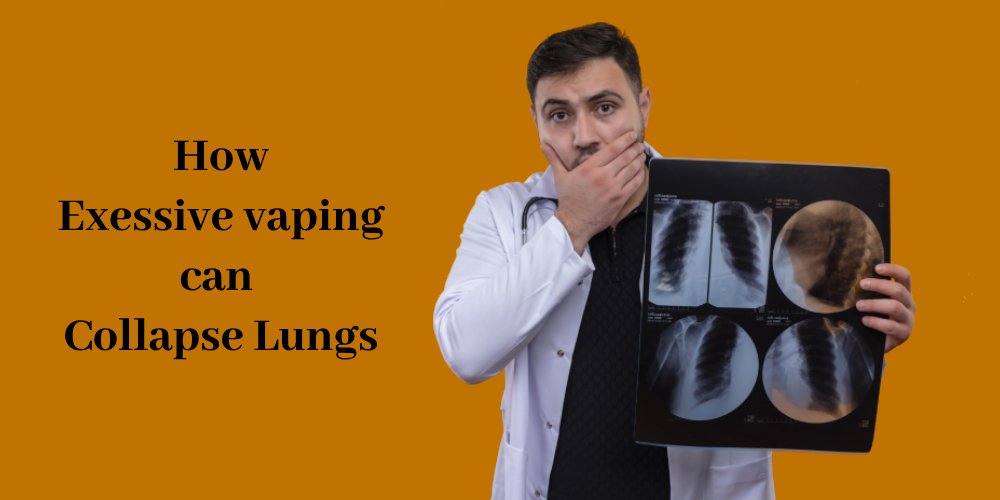
How Excessive Vaping Can Collapse Your Lungs
Vaping has rapidly emerged as a trendy alternative to traditional smoking, especially among young adults and teenagers. The allure of sleek devices, a plethora of enticing flavors, and the perception that it’s a safer habit than smoking cigarettes have led many to pick up vaping without fully understanding the potential health consequences. But here’s a startling fact: a UK teenager recently had her lung collapse after vaping the equivalent of 400 cigarettes a week. This shocking incident is a stark reminder that vaping is far from harmless.
Imagine being able to enjoy the sweet taste of strawberry or the refreshing coolness of mint, all while thinking you’re dodging the bullet of smoking-related diseases. However, beneath this appealing surface lies a dark reality. The chemicals involved in vaping, the physical strain on the lungs, and the addictive nature of nicotine can lead to severe health issues, including the risk of a collapsed lung, medically known as pneumothorax.
In this blog, we will delve into how excessive vaping can lead to this critical condition, explore the underlying mechanisms, and highlight the importance of understanding the risks associated with vaping. Drawing from recent studies and real-life cases we’ll shed light on the dangers that vaping poses to lung health. Whether you’re a seasoned vaper, a concerned parent, or someone considering vaping, this information is crucial for making informed decisions about your health. Let’s dive into the details and uncover the serious consequences of excessive vaping.
Understanding Vaping and Its Popularity
Vaping involves inhaling a vapor produced by an electronic cigarette (e-cigarette) or similar device. These devices heat a liquid that usually contains nicotine, flavorings, and other chemicals. The appeal of vaping lies in its variety and perceived safety compared to traditional smoking. However, the long-term health effects of vaping are still under study, and emerging evidence suggests that it is far from safe.
What Is Pneumothorax?
Pneumothorax, commonly referred to as a collapsed lung, is a medical condition where air escapes from the lung and fills the space between the lung and the chest wall. This air buildup exerts pressure on the lung, causing it to collapse either partially or completely. The severity of the condition can vary, with some cases being minor and others requiring urgent medical intervention.
Consider the lungs as balloons. Under normal conditions, these balloons inflate and deflate effortlessly, allowing you to breathe in oxygen and expel carbon dioxide. However, when a pneumothorax occurs, it’s as if a small puncture or tear has developed in one of these balloons. The escaping air gets trapped in the pleural space, the area between the lung and the chest wall, disrupting the normal function of the lung. This can lead to a range of symptoms including sudden chest pain, shortness of breath, rapid heart rate, and in severe cases, respiratory failure.
One increasingly concerning cause is excessive vaping. The inhalation of heated vapor containing various chemicals can irritate and damage the delicate tissues of the lungs. Over time, this damage can lead to weaknesses or tears, allowing air to escape into the pleural space.
The Link Between Vaping and Pneumothorax
Recent studies and medical reports have linked excessive vaping to cases of pneumothorax. The exact mechanisms are still being researched, but several factors contribute to this serious health risk:
- Chemical Exposure: Vaping exposes the lungs to various chemicals, including nicotine, propylene glycol, and vegetable glycerin. Some of these substances can irritate and damage lung tissue.
- Pressure Changes: The act of vaping involves repeated deep inhalations, which can create significant pressure changes in the lungs. This repetitive stress can weaken lung tissue over time, making it more susceptible to tearing and collapsing.
- Pre-existing Conditions: Individuals with pre-existing lung conditions, such as asthma or chronic obstructive pulmonary disease (COPD), are at higher risk. The additional strain from vaping can exacerbate these conditions, leading to complications like pneumothorax.
Real-Life Example: The UK Teen’s Shocking Story
Consider the alarming case of a UK teenager whose lung collapsed after vaping excessively. According to reports, the teen had been vaping the equivalent of 400 cigarettes a week. This excessive use led to the development of a severe lung condition, culminating in the collapse of one of his lungs. His story is a stark reminder of the potential dangers of vaping, especially when used excessively.
The Role of Flavored E-liquids
Flavored e-liquids are particularly popular among young people. However, some flavoring agents, when heated and inhaled, can produce harmful byproducts. For example, diacetyl, a chemical used in some flavors, has been linked to a serious lung condition known as “popcorn lung” (bronchiolitis obliterans). Although diacetyl is banned in e-liquids in many countries, other harmful chemicals can still be present.
Research and Studies
A study published in the American Journal of Respiratory and Critical Care Medicine found that certain chemicals in e-liquids can cause inflammation and damage lung tissue. Another study from the University of Rochester Medical Center showed that vaping can suppress immune genes in the respiratory system, making it more difficult for the lungs to respond to infections and injuries.
Moreover, the Centers for Disease Control and Prevention (CDC) reported an outbreak of e-cigarette or vaping product use-associated lung injury (EVALI) in 2019, which led to several deaths and thousands of hospitalizations. While the primary cause was linked to vitamin E acetate in THC-containing products, the incident highlighted the potential severe risks associated with vaping.
Signs and Symptoms of Pneumothorax
It’s crucial to recognize the signs and symptoms of pneumothorax, especially if you or someone you know vapes regularly. Symptoms include:
- Sudden chest pain
- Shortness of breath
- Rapid heart rate
- Fatigue
- Bluish skin (cyanosis) due to lack of oxygen
If you experience any of these symptoms, seek medical attention immediately.
Preventing Lung Collapse
The most effective way to prevent vaping-related lung collapse is to avoid vaping altogether. If you are already vaping, consider reducing your usage and seeking support to quit. Here are some strategies:
- Education: Understanding the risks associated with vaping can be a powerful motivator to quit. Stay informed about the latest research and health advisories.
- Support Groups: Join online or in-person support groups where you can share your experiences and receive encouragement from others who are also trying to quit.
- Professional Help: Consult healthcare professionals who can provide personalized advice and treatment options to help you quit vaping.
- Healthy Alternatives: Engage in healthy activities and hobbies that can distract you from the urge to vape. Exercise, meditation, and spending time with friends and family can be effective alternatives.
The case of the UK teenager and the growing body of research makes it clear that excessive vaping can have dire consequences. While vaping may seem like a safer alternative to smoking, it carries significant risks that should not be overlooked. By seeking support, and making healthy choices, you can protect your lungs and overall health.
Understanding the potential risks and taking proactive steps to quit vaping is essential. The journey might be challenging, but with the right support and determination, it is possible to overcome the addiction and enjoy a healthier, vape-free life. Stay informed, stay safe.




